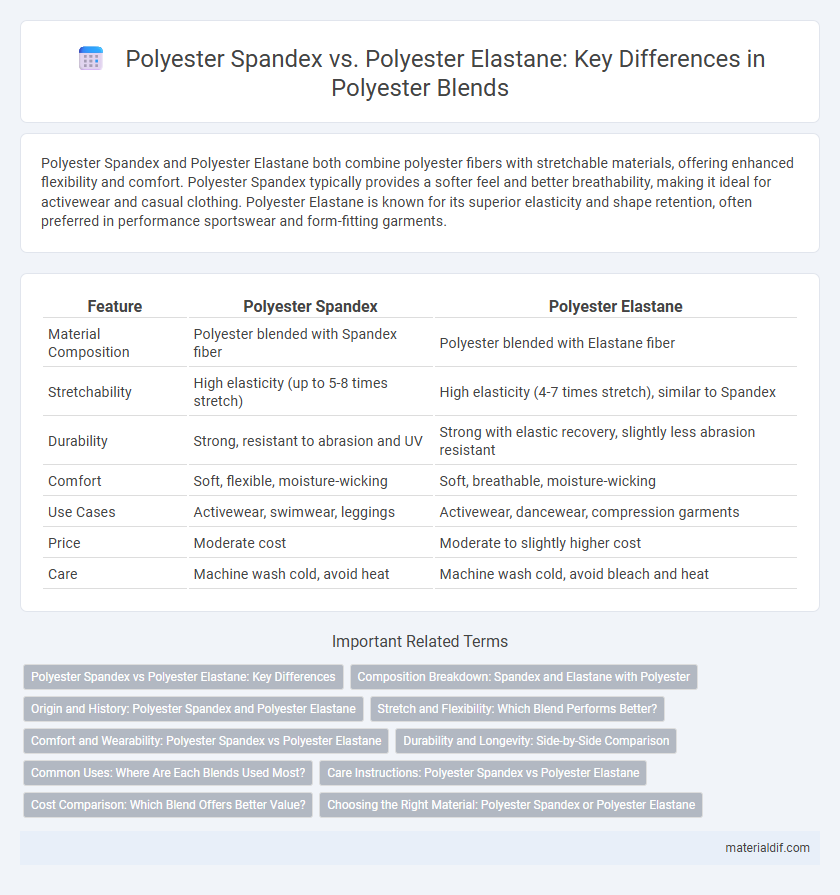Polyester Spandex and Polyester Elastane both combine polyester fibers with stretchable materials, offering enhanced flexibility and comfort. Polyester Spandex typically provides a softer feel and better breathability, making it ideal for activewear and casual clothing. Polyester Elastane is known for its superior elasticity and shape retention, often preferred in performance sportswear and form-fitting garments.
Table of Comparison
| Feature | Polyester Spandex | Polyester Elastane |
|---|---|---|
| Material Composition | Polyester blended with Spandex fiber | Polyester blended with Elastane fiber |
| Stretchability | High elasticity (up to 5-8 times stretch) | High elasticity (4-7 times stretch), similar to Spandex |
| Durability | Strong, resistant to abrasion and UV | Strong with elastic recovery, slightly less abrasion resistant |
| Comfort | Soft, flexible, moisture-wicking | Soft, breathable, moisture-wicking |
| Use Cases | Activewear, swimwear, leggings | Activewear, dancewear, compression garments |
| Price | Moderate cost | Moderate to slightly higher cost |
| Care | Machine wash cold, avoid heat | Machine wash cold, avoid bleach and heat |
Polyester Spandex vs Polyester Elastane: Key Differences
Polyester Spandex and Polyester Elastane both combine polyester fibers with stretchable materials, but the key difference lies in the type of stretch fiber used--spandex versus elastane, which are often chemically similar yet marketed differently based on region and brand. Polyester Spandex typically refers to fabrics with a higher elasticity ideal for activewear and performance apparel, while Polyester Elastane offers slightly different stretch recovery and comfort levels favored in fashion and casual wear. Understanding these distinctions ensures better fabric selection for durability, stretch, and end-use application, optimizing garment functionality and consumer satisfaction.
Composition Breakdown: Spandex and Elastane with Polyester
Polyester Spandex and Polyester Elastane blends primarily consist of a polyester base combined with either spandex or elastane fibers, both providing exceptional stretch and recovery properties. The typical composition ranges from 85-92% polyester to 8-15% spandex or elastane, optimizing comfort, flexibility, and durability. While spandex and elastane are chemically similar polyurethane fibers, elastane is commonly the term used in Europe, with negligible differences in performance when blended with polyester.
Origin and History: Polyester Spandex and Polyester Elastane
Polyester Spandex and Polyester Elastane both originate from synthetic fibers developed in the mid-20th century, with polyester first introduced in the 1940s by British chemists John Rex Whinfield and James Tennant Dickson. Spandex, trademarked as Lycra, was created in the late 1950s by chemist Joseph Shivers at DuPont, while elastane is the European name for the same fiber, emphasizing the material's elasticity. These blends combine polyester's durability with the stretch of spandex/elastane, revolutionizing activewear and fashion industries since their inception.
Stretch and Flexibility: Which Blend Performs Better?
Polyester spandex and polyester elastane blends both offer excellent stretch and flexibility, but polyester elastane typically provides superior elasticity and recovery due to elastane's enhanced elongation properties. Fabrics with polyester elastane blends maintain shape longer during extensive wear and intense physical activity, making them more suitable for activewear and performance garments. Polyester spandex, while still stretchy, often has a slightly lower stretch capacity and may not recover as quickly after repeated stretching.
Comfort and Wearability: Polyester Spandex vs Polyester Elastane
Polyester spandex and polyester elastane both offer excellent stretch and recovery, enhancing comfort and wearability in activewear and casual garments. Polyester spandex tends to provide a slightly softer feel and more flexibility, making it ideal for tight-fitting apparel requiring maximum movement. Polyester elastane, while similar, often delivers more durability and moisture-wicking properties, improving wearability for intense physical activities.
Durability and Longevity: Side-by-Side Comparison
Polyester spandex and polyester elastane both offer excellent durability and longevity due to their synthetic fiber composition, but polyester spandex tends to provide higher resistance to stretching and wear, making it ideal for activewear. Polyester elastane, while similarly durable, has a slightly softer texture and more elasticity, which may result in marginally faster fabric fatigue under constant stress. Overall, polyester spandex generally outperforms elastane blends in maintaining shape and strength over prolonged use.
Common Uses: Where Are Each Blends Used Most?
Polyester spandex blends are predominantly used in activewear and sportswear due to their superior stretch and moisture-wicking properties, enhancing comfort and flexibility during physical activities. Polyester elastane fabrics are commonly found in casual and fashion apparel, such as leggings and fitted dresses, providing a soft stretch that maintains shape and fit throughout wear. Both blends are popular in performance and everyday clothing, but spandex is favored for high-intensity movement while elastane is preferred for its subtle elasticity and smooth texture.
Care Instructions: Polyester Spandex vs Polyester Elastane
Polyester Spandex and Polyester Elastane both require gentle care to maintain fabric elasticity and durability, typically recommending cold water washing and low heat drying. Avoid bleach and fabric softeners as they can degrade the fibers, while hand washing or using a delicate cycle preserves stretch properties in both materials. Ironing at low temperatures is advised to prevent damage, ensuring long-lasting performance for garments made from either fiber blend.
Cost Comparison: Which Blend Offers Better Value?
Polyester Spandex typically costs less than Polyester Elastane, making it a more budget-friendly option for manufacturers and consumers. Polyester Elastane provides enhanced stretch and durability but comes at a higher price point due to its advanced fabric technology. Evaluating both blends reveals that Polyester Spandex offers better value for everyday wear, while Polyester Elastane is preferred for premium performance and long-lasting garments.
Choosing the Right Material: Polyester Spandex or Polyester Elastane
Polyester Spandex and Polyester Elastane are often used interchangeably but differ slightly in stretch and recovery properties, with spandex offering superior elasticity ideal for activewear and fitted garments. Polyester Elastane blends provide durable stretch with better moisture-wicking properties, making them suitable for performance apparel requiring breathability and comfort. Choosing between the two depends on the specific requirements of fabric flexibility, durability, and intended use in garments.
Polyester Spandex vs Polyester Elastane Infographic

 materialdif.com
materialdif.com